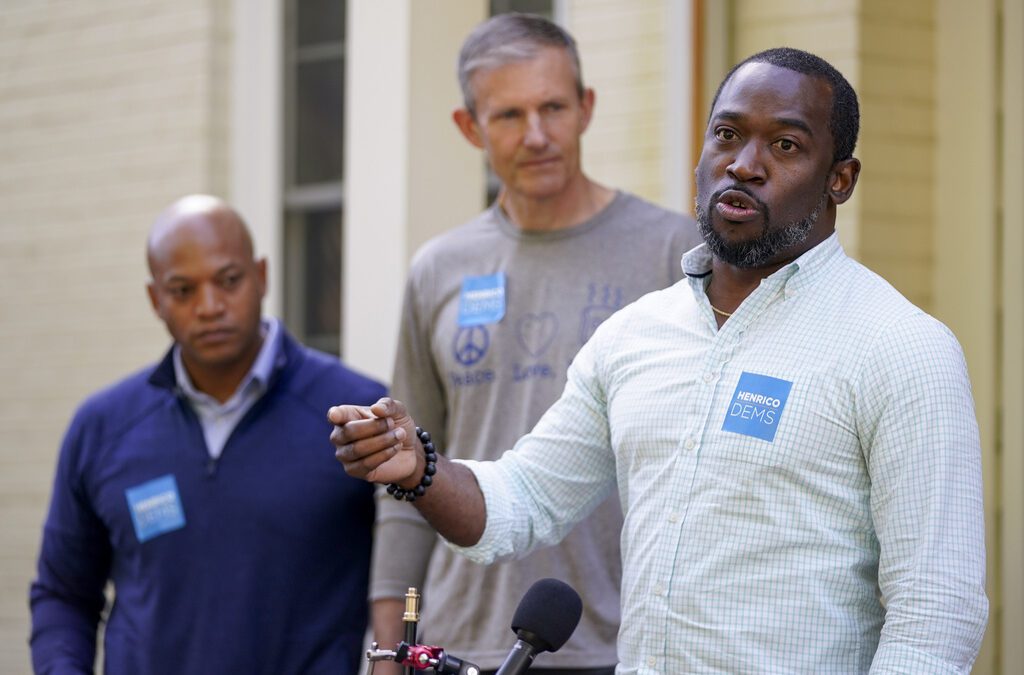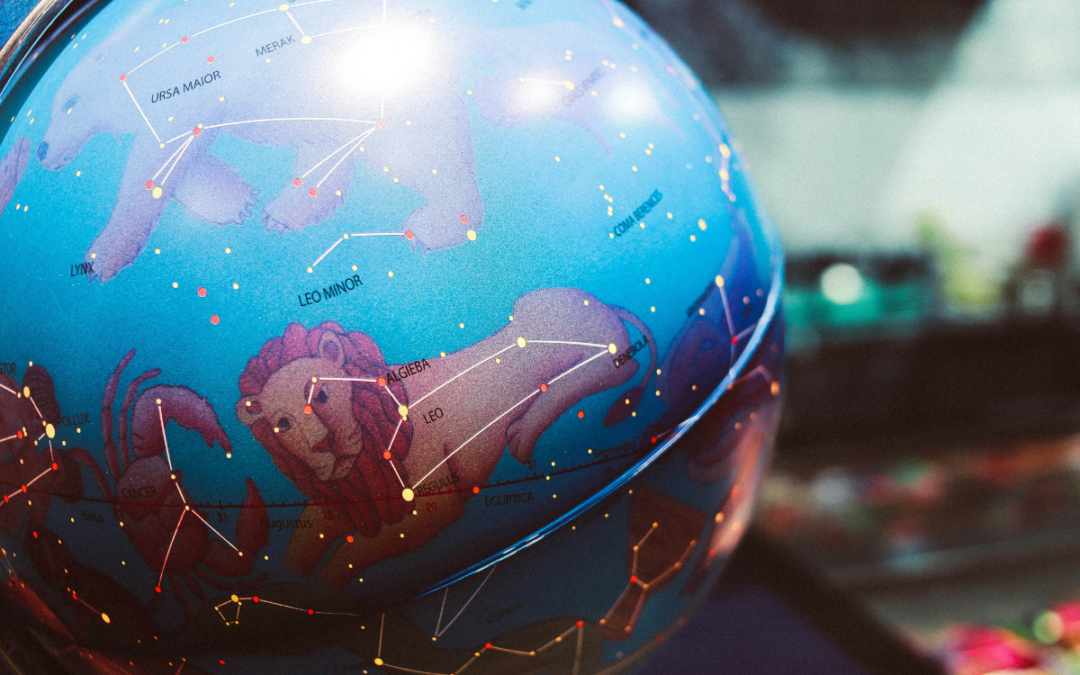
Members of the Mocanan tribe are pictured here at the 2018 Blacksburg Native Spring Pow Wow, taking part in a traditional dance.
Kluge-Ruhe’s efforts are a ‘good first step,’ tribal officials say
FLOYD- The works displayed at Charlottesville’s Kluge-Ruhe Aboriginal Art Collection are for everyone to enjoy. But curator Henry Skerritt strives to ensure that Indigenous Australian communities always retain a sense of ownership over the art.
In his four years overseeing the collection, Skerritt has traveled to Australia six times, and often hosts resident artists at the museum. A native Australian, Skerritt said efforts to honor the traditional authority of Aboriginal people are customary back home.
When Indigenous Australians visit Charlottesville, he said, “one of the first things they’ll say is, ‘Who are the local people?’”
Translation: Which Native American tribes lived on this land before colonizers stole it? The reason, Skerritt said, is because of a mutual respect between native tribes in America and Australia.
And so, the first thing a visitor sees on the museum’s website is a banner acknowledging the Monacan people who traditionally owned the land in Charlottesville. Museum officials read a similar statement at all events. You also see it in the building’s entryway. The Monacan Nation is one of eight indigenous tribes recognized by the Virginia General Assembly. They currently own 110 acres on Bear Mountain in Amherst County.
“The indigenous people of Virginia have been under elitist institutional organizations and the government for centuries. My people retreated to the mountains. Other tribes retreated to swamps and coastal lands. The acknowledgement of the ancestral ownership is acknowledging where our ancestors are – it is part of our story and history,” explained Teresa Pollak, a current member of the Monacan Nation.
Skerritt said the acknowledgement statement is a small way the museum can leverage its institutional power.
“We didn’t invent the idea—Indigenous people have been asking for this for a long time,” he said. “Our role as we see it, is just to agitate for that.”
RELATED: Keeping Tradition Alive: Jamestown Pays Tribute to Native Tribes
‘A big step for Kluge-Ruhe’
The museum worked closely with Karenne Wood, a member of the Monacan tribe, to develop the statement. Pollack called her “a dear friend who was as close to me as a sister.” She passed away earlier this year and the Indigenous page on Kluge-Ruhe’s website stands in tribute. The ownership statement is also a tribute to Wood’s efforts. Kluge-Ruhe is part of the University of Virginia. University President Jim Ryan issues the statement during on-campus events, drawing more attention to the tribe.
But Skerritt and other university officials are working to do more than just acknowledge the Monacan tribe. On Oct. 16, Ryan and other members of the University’s senior leadership met with activists for Indigenous rights and members of the Monacan Nation. The goal was to try and repair relationships between the University and Virginia’s Native people, Skerritt said. While university officials made no firm commitments during the meeting, Skerritt said there is positive momentum.
Pollak called the meeting “a first step.” While she can’t speak for all Native people, Pollack hopes “that UVA will do the right thing and institute a policy of tribal consultation with the Virginia Nations.”
Skerritt drew a parallel between the University’s efforts to reckon with its history with Native people and its construction of the Memorial to Enslaved Laborers. Young activists and students led that effort.
Connecting through common experiences
Likewise, at Springhouse Community School in Floyd County, Communications Coordinator Carolyn Reilly sees the younger generation catalyzing greater inclusivity. The private alternative school hosts grades 7-12.
Reilly’s email signature includes a statement acknowledging the Tutelo people as ancestral owners of the land in Southwest Virginia. It’s part of a collective effort at the school to learn about Native culture. A member of the school’s board, Andrew Callister, also reached out to the Monacan Nation earlier this year.
Callister is also from Australia and shares Skerritt’s familiarity with methods to honor ancestral land owners. The pandemic paused efforts to connect with the tribe.
Reilly said the curriculum at Springhouse “does not tiptoe around the uncomfortable topics of the day.” She just finished teaching a class that explored “decolonizing our thinking as white people,” she said. Springhouse courses are framed around racial justice, a concept Reilly said is relevant to understanding Native history.
A fight to protect her family farm in nearby Franklin County from the Mountain Valley Pipeline was eye-opening.
“So here I am, this white woman…working alongside nature, and really learning from the land,” Reilly recounted. “And I’m learning about property rights, and eminent domain, and what does it mean when these big gas companies are coming through? You really feel powerless.”
Reilly watched similar conflicts unfold at Standing Rock. She realized she was defending stolen land.
“How do I still fight for what I believe in, and also hold the truth that this [land] was taken by white people hundreds of years ago?” she asked herself.
Reilly connected with Native people living in Virginia, who visited the farm and offered ceremony and prayers. The pipeline prevailed, though, and Reilly moved to Floyd, where she continued her study of the ancestral owners of her home.
Sorting Fact From Fiction: Sign Up Here for Dogwood’s Newsletter
‘The land is family’
Skerritt said Virginians should have an inherent empathy for these land owners.
“The reality is that we all feel connections to places. We look at a place like Virginia, where if you haven’t lived somewhere for four generations, you’re considered a newcomer,” Skerritt said.
For Indigenous people, including the Aboriginal Australians with which he is most familiar, “it runs even deeper…there’s an embodied ancestral connection to the land that spans tens of thousands of years,” he said. “The land is family.”
Aboriginal Australians and Native Americans don’t share an identical history or perspective. But recognition by the government and control over ancestral lands are long-held demands of both groups. The Monacan Nation is one of the few American Indian nations that still resides on its ancestral homeland, according to its website. In 1994, the tribe began negotiating with the Episcopal Diocese of Southwest Virginia to open a tribal museum at its mission site in Amherst County. The church subsequently made history by returning the property’s deed back to the tribe.
The Springhouse staff knows making reparations will be a long process.
“We know that this is not one and done, just because we say we honor the original people of this land,” Reilly said.
Pollak echoed the sentiment. Acknowledgement statements are only the beginning, she said, as “actions speak louder than words.”
Ashley Spinks Dugan is a freelance reporter with Dogwood. You can reach her at [email protected].
Politics

Biden administration bans noncompete clauses for workers
The Federal Trade Commission (FTC) voted on Tuesday to ban noncompete agreements—those pesky clauses that employers often force their workers to...

Democratic shakeup in Virginia primaries for governor, lieutenant governor
Richmond Mayor Levar Stoney quit his bid for governor and jumped into the race to be the Democratic nominee for lieutenant governor. The race for...
Local News

The zodiac signs of 12 iconic women offer insight into their historic accomplishments
Zodiac signs can tell you a lot about someone’s personality. Whether they’re an earth, water, air, or fire sign, these 12 categories (which are...

Virginia verses: Celebrating 5 poetic icons for National Poetry Month
There’s no shortage of great writers when it comes to our commonwealth. From the haunting verses of Edgar Allan Poe, who found solace in Richmond's...




